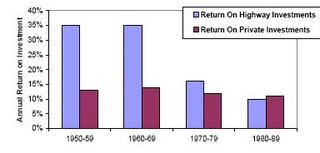As many have argued in this blog, the gas tax has its flaws as a vehicle for raising money to fund ongoing roadway maintenance and construction. The flaws will become increasingly evident as Americans shift to vehicles with better gas mileage — or to electric automobiles that don’t consume any gasoline at all. Some, including myself, have argued that Virginia should move to a system that charges automobiles on the basis of Vehicle Miles Driven: The more you drive, the more you pay.
The issue has been this: Does the technology exist to track Vehicle Miles Driven cheaply and unobtrusively? We have an answer: Almost. A Canadian company is developing technology, which it expects to roll out in a year, that will transform the way people think about transportation.
Toronto-based Applied Location Corporation was profiled by Business 2.0 magazine in a list of 11 disruptive new technologies. Founder Bern Grush has created a satellite-based system, Skymeter, for toll collection, traffic congestion management, and pay-as-you-drive insurance. Writes Business 2.0:
He says he’s created an algorithm that corrects for the noise and missed signals to which GPS is prone, especially in urban canyons, so Skymeter can reliably pinpoint a car’s location to within 1.5 meters. Once that becomes possible, cities can start to manage traffic better by charging more for driving during peak times. (London already does this, but with an expensive system of cameras.) “The problem is congestion,” Grush says. “We need to send pricing signals to motorists to drive at alternate times.”
Skymeter is disruptive more for the new economic models it might spur than for what it might displace. For instance, in addition to congestion tolls, it could be used to charge for parking anywhere in a city, even where there are no meters. Or the technology could enable insurance companies to offer better rates to safer drivers, since it records speed, time of day, and driving route. …
Grush thinks his product could ultimately help to supplement or even replace the fuel tax now used to pay for the upkeep of our roads. “The need to fix road financing and congestion is so acute,” he argues, “that a dramatic shift will necessarily occur.”
Virginia is running out of money to maintain its road network. We need to envision a future that abolishes the gasoline tax and replaces it with a tax based on Vehicle Miles Driven, adjusted perhaps for the weight of the vehicle. This tax would cover the maintenance of the road network. As maintenance costs increase (or conceivably decrease, if we outsource maintenance), the tax would adjust automatically each year.
Funds for new construction would come from tolls — ideally, tolls that varied the price according to congestion levels. With such a two-track system, Virginia could ensure that (a) all maintenance costs were covered, (b) that tolls encouraged people to drive during off-peak periods or to shift to carpooling, buses, rail or telecommuting, and (c) that the money for new construction came directly from the people who used the new facilities. We could then turn the conversation from how much money we need, and where to get it, to a more productive dialogue: how best to align our transportation systems with our human settlement patterns.
As lawmakers discuss Virginia’s transportation funding in the soon-to-convene special session, they need to be thinking about the larger context: emerging technologies and new, user-pays transportation-funding models that are sweeping the world.





